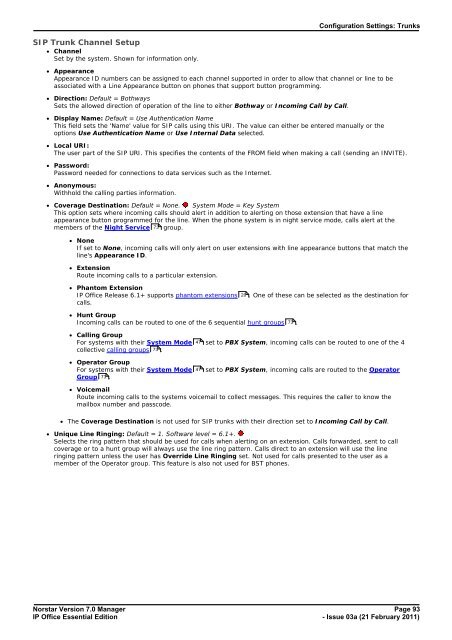Norstar Version - IP Office Info
Norstar Version - IP Office Info
Norstar Version - IP Office Info
You also want an ePaper? Increase the reach of your titles
YUMPU automatically turns print PDFs into web optimized ePapers that Google loves.
Configuration Settings: Trunks<br />
S<strong>IP</strong> Trunk Channel Setup<br />
· Channel<br />
Set by the system. Shown for information only.<br />
· Appearance<br />
Appearance ID numbers can be assigned to each channel supported in order to allow that channel or line to be<br />
associated with a Line Appearance button on phones that support button programming.<br />
· Direction: Default = Bothways<br />
Sets the allowed direction of operation of the line to either Bothway or Incoming Call by Call.<br />
· Display Name: Default = Use Authentication Name<br />
This field sets the 'Name' value for S<strong>IP</strong> calls using this URI. The value can either be entered manually or the<br />
options Use Authentication Name or Use Internal Data selected.<br />
· Local URI:<br />
The user part of the S<strong>IP</strong> URI. This specifies the contents of the FROM field when making a call (sending an INVITE).<br />
· Password:<br />
Password needed for connections to data services such as the Internet.<br />
· Anonymous:<br />
Withhold the calling parties information.<br />
· Coverage Destination: Default = None. System Mode = Key System<br />
This option sets where incoming calls should alert in addition to alerting on those extension that have a line<br />
appearance button programmed for the line. When the phone system is in night service mode, calls alert at the<br />
members of the Night Service 73 group.<br />
· None<br />
If set to None, incoming calls will only alert on user extensions with line appearance buttons that match the<br />
line's Appearance ID.<br />
· Extension<br />
Route incoming calls to a particular extension.<br />
· Phantom Extension<br />
<strong>IP</strong> <strong>Office</strong> Release 6.1+ supports phantom extensions<br />
calls.<br />
20 . One of these can be selected as the destination for<br />
· Hunt Group<br />
Incoming calls can be routed to one of the 6 sequential hunt groups 73 .<br />
· Calling Group<br />
For systems with their System Mode 47 set to PBX System, incoming calls can be routed to one of the 4<br />
collective calling groups 73 .<br />
· Operator Group<br />
For systems with their System Mode 47 set to PBX System, incoming calls are routed to the Operator<br />
Group 73 .<br />
· Voicemail<br />
Route incoming calls to the systems voicemail to collect messages. This requires the caller to know the<br />
mailbox number and passcode.<br />
· The Coverage Destination is not used for S<strong>IP</strong> trunks with their direction set to Incoming Call by Call.<br />
· Unique Line Ringing: Default = 1. Software level = 6.1+.<br />
Selects the ring pattern that should be used for calls when alerting on an extension. Calls forwarded, sent to call<br />
coverage or to a hunt group will always use the line ring pattern. Calls direct to an extension will use the line<br />
ringing pattern unless the user has Override Line Ringing set. Not used for calls presented to the user as a<br />
member of the Operator group. This feature is also not used for BST phones.<br />
<strong>Norstar</strong> <strong>Version</strong> 7.0 Manager Page 93<br />
<strong>IP</strong> <strong>Office</strong> Essential Edition<br />
- Issue 03a (21 February 2011)

















